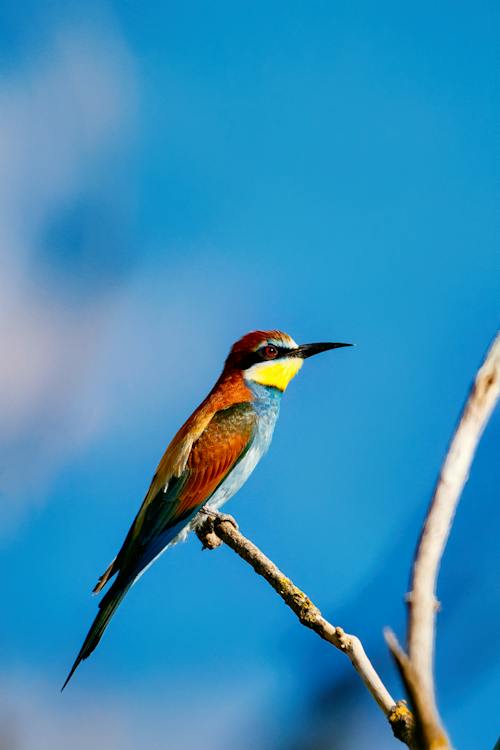It a stunning, seemingly rainbow-colored, near-passerine migratory bird. Frequents open and semi-open country, specifically drier regions. This bird is often seen in small groups, circing while on wings or perching on wires. As its name suggests, bees compose most it diet, catching them and other insects while in flight.
Read further to know more about the European Bee-eater.
What is a European Bee-eater?
European Bee-eater (Merops apiaster), also Golden or Eurasian Bee-eaters, is a near passerine bird species belonging to the family Meropidae of bee-eaters. It breeds in southern Europe, western Asia, and northern Africa, then migrates to tropical Africa during the winter. They are generally timid but may come near to human settlements after the rains, searching for beehives.
Its seven levels of classification are as follows:
Kingdom: Animalia
Phylum: Chordata
Class: Aves
Order: Coraciiformes
Family: Meropidae
Genus: Merops
Species: M. apiaster
European Bee-eater Physical Description
European Bee-eater, grows 9.8 to 11.4 inches or 25 to 39 centimeters in length (central tail feathers included), weighing 55 grams or 1.9 ounces, with a wingspan of 14.1 to 15.6 inches or 36-40 centimeters. Their upperpart is brown and yellow, while the rump has a paler yellow tone. Underpart is greenish-blue. Meanwhile, tail, streamers, and wings are green. Underwing and undertail appear to be greyish-white.
On the head, the base of the upper bill is white. Crown has a dark chestnut while the forehead appears greenish-blue. Lores are black, stretching across the eye until the ear tetrices forming a black band, subtly edged by dull greenish-blue tone. Eyes are red. Legs and feet are grayish-brown. The bill is pointed but slightly arched downward. Both sexes look similar, but the female’s back appears to be greener, while wing feathers are paler green.
Where can they be spotted?
European Bee-eaters are summer breeders in southern Europe, western Asia, and northern Africa, then winters in tropical Africa. In its breeding range, it prefers pastures, river valleys, cultivated areas, plains, hillsides, meadows, plantations, and crop fields. In its wintering habitat, these birds occur in lakeshores, savannas, and cultivated regions.
Interesting Facts You Should Know About the European Bee-eater
As their name suggests, European Bee-eaters feed mainly on bees, hornets, and wasps. They catch these insects while on the flight, charing from their perches. Prior to swallowing, these birds smash the prey item against the perch to remove the sting and devenom them. Other insects in its diet include cicadas, termites, butterflies, dragonflies, and grasshoppers. These bee-eaters often regurgitate pellets, consisting of the undigested part of insects they consume.
During the breeding season, these birds perform courtships antics, that highlights their colorful plumage. The feathers on the crown and neck are erected. Wings are raised, while the tail is fanned. The pair faces each other, bobbing their heads up and down. Flight displays are also be observed, characterized by glides, shallow wingbeats, and butterfly-resembling flights, with the male, loudly calling. Lastly, courtship feeding occurs with the males hunting and offering the females food. Copulation happens after a few offers.
The breeding season differs depending on the range. They nests in loosely-structured colonies. The pair, along with some helpers or non-breeding adults, digs burrows on sloping or flat ground, on riverside banks or earthen cliffs.
The female will lay a clutch consisting of 4-10 eggs, some days apart. Incubation lasts 13-20 days also depending on the range, with both sexes taking intervals. All eggs will hatch within six days after the first chick. Both parents and the helpers will feed broods, which leave the nest after a month from hatching.
While the species is threatened by hunting, use of pesticides that cause a decline in their food source, and loss of their nesting sites due to river canalization, their population do not reach decline thresholds, and they are currently classified as Least Concern (LC) under the IUCN Red List of Threatened Species.
WILDLIFE PARKS AND RESERVES WHERE THIS SPECIES IS FOUND:
BOTSWANA
SOUTH AFRICA
Kalahari Gemsbok National Park
NAMIBIA
ZAMBIA
ZIMBABWE
BOTSWANA BIRDS | SOUTH AFRICA BIRDS
NAMIBIA BIRDS | ZAMBIA BIRDS | ZIMBABWE BIRDS
